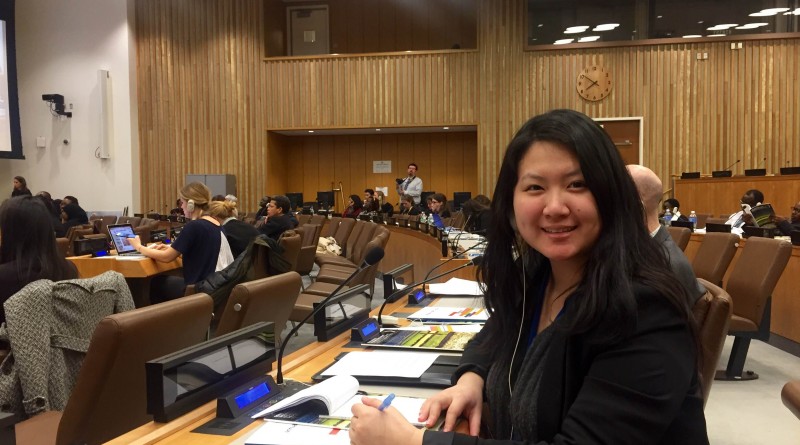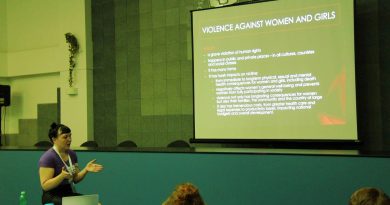CGNK at the 60th session of the UN Commission on the Status of Women
CGNK’s Representative to the United Nations New York Headquarters Winnie Wang participated at the 60th session of the Commission on the Status of Women that took place at the UNHQ in New York from 14 to 24 March 2016. This session’s priority theme was the empowerment of women and its links to the Sustainable Development Goals and the review of the elimination and prevention of all forms of violence against women and girls. With that in mind, CGNG submitted a formal written statement “Addressing Violence Against Women as part of the Sustainable Development Goals” that was distributed among all participating delegations.
Although CGNK had also contributed with Written Statements to previous CSW sessions, namely on the issue of nonkilling and the SDG agenda in the 59th session, this is the first time CGNK is physically present at the UN New York Headquarters participating at this kind of high-level event. Winnie Wang joined CGNK as a volunteer in December 2015, having graduated from Yale University with a degree in History of Science, Medicine, and Public Health, and is since serving as CGNK UN Representative in New York.
The English, French, and Spanish versions of the statement can be downloaded here or from the official UN documentation site under reference number E/CN.6/2016/NGO/7.
Addressing Violence Against Women as part of the Sustainable Development Goals
In its Statement for the 59th Session of the Commission on the Status of Women (E/CN.6/2015/NGO/21) the Center for Global Nonkilling strongly supported the inclusion of targets focused on the prevention and reduction of lethal and other forms of violence against women as part of the post-2015 development agenda. The inclusion in the Sustainable Development Goals of targets seeking to “eliminate all forms of violence against all women and girls” (5.2) and to “significantly reduce all forms of violence and related death rates everywhere” (16.1), together with other targets, is a significant step forward in addressing the global burden of killing.
The months ahead will determine if these goals are translated into concrete action that will bring real change by 2030 or if they will otherwise become a dead letter, in this case also literally. Millions of people are affected by violence every year. The 2014 “Global status report on violence prevention” revealed that 475,000 people were murdered in 2012, excluding thousands more killed in armed conflict. Although males represent the majority both of victims and perpetrators (homicide is the third leading cause of death globally for males aged 15-44 years), women and girls bear a higher burden of non-fatal violence, including physical, sexual and psychological violence.
The World Health Organization estimated in 2013 that 38 per cent of female homicides globally are committed by male partners. But while a majority of programmes focus on the victims, efforts to prevent violence by addressing potential perpetrators are still weak. Trying to achieve Sustainable Development Goals target 5.2 without considering the wider societal norms and values related to killing and threats to kill will most certainly lead to failure. Only a multi-sectorial approach that understands the problem of violence, and particularly the actual or potential use of lethal violence, in its broad socio-ecological context will be able to design and implement policies that can not only bring us closer to ending violence against women and girls, but actually move us towards the envisioned peaceful non-killing societies (Sustainable Development Goals target 16.1).
The Sustainable Development Goals represent a political opportunity for addressing violence against women and girls as part of a global prevention effort to significantly reduce killing and other forms of non-lethal violence. We currently have the knowledge needed to drastically reduce death rates everywhere and build killing-free societies. In 2015, the report of a World Health Organization conference at the University of Cambridge presents “Global Strategies to Reduce Violence by 50 per cent in the Next 30 Years”. The Global Status Report on Violence Prevention, published by the World Health Organization, the United Nations Office on Drugs and Crime and the United Nations Development Programme, presented an encouraging 16 per cent global decline of homicide rates since 2002. But this is far from enough.
If significant know-how already exists within the United Nations and its Member States and across a broad spectrum of civil society organizations, failure to seize this opportunity for building safe killing-free communities worldwide may jeopardize other development goals, as already established by the United Nations General Assembly in resolution: “Promoting Development through the Reduction and Prevention of Armed Violence” (A/RES/63/23). A clear understanding should exist about the interdependence of Sustainable Development Goals: failure to address certain targets will obstruct advances in others. Although advancement in targets related on poverty (1.1, 1.2, 1.3), health (3.4, 3.5, 3.8), education (4.2, 4.7, 4a), inequality (10.2, 10.3), housing (11.1, 11.3), or weapons availability (16.4), to mention some issues that have shown significant correlation with violence in existing literature, will most likely have a positive effect in the reduction of homicide rates, disregarding violence prevention as an integral part of the solution could undermine the process and even lead to unwarranted harmful practices.
While Sustainable Development Goals 5.2 strongly resonates and reaffirms the Beijing Declaration and Platform for Action signatories’ determination to “Prevent and eliminate all forms of violence against women and girls”, both the scientific literature on violence prevention and the evidence from applied programmes suggest that for efforts to be effective they should be guided by the knowledge on risk and protective factors. To prevent violence against women and girls, much of the focus should be on children, adolescents and young adults, particularly males, as it is within these segments that interventions have proven to be most effective. In fact, male adolescents and young adults are disproportionately impacted by violence, and are also the most common perpetrators of violence in general, and homicides and non-fatal violence against women and girls in particular.
But just as programmes focusing on childhood, particularly in early-childhood are the most promising in terms of creating the real change that is required, we also know that they can take up to 15 years to show their effects statistically, having the potential for population level change (and thus macro declines of homicides) just on the 2030 outer time limit of the Sustainable Development Goals. Leaving political calculations aside, it is crucial that early-childhood interventions (including the still invisible problem of obstetric violence) are not disregarded, as they offer the greatest potential for meeting the aim included in the Preamble of the 2030 Agenda for Sustainable Development: “We are determined to foster peaceful, just and inclusive societies which are free from fear and violence. There can be no sustainable development without peace and no peace without sustainable development.”
Upholding the recommendations of the World Health Organization’s “Violence Prevention Alliance”, we hereby call for (1) Scaling up prevention programmes that have been proven successful; (2) Ensuring that existing laws relevant to violence prevention are fully enforced, ending with impunity especially in regard to violence against women and girls; (3) Tracking progress towards its reduction and eventual elimination by strengthening data collection. For this to happen a shift of attention towards prevention must occur at the United Nations and in Member States. Funding and staffing for United Nations agencies and departments working on prevention of violence should be expanded and violence prevention should be considered a transversal component for action across the United Nation system. Ministries and infrastructures for peace, and non-killing are needed in every country. Civil society organizations and academic institutions working to prevent violence should be empowered.




